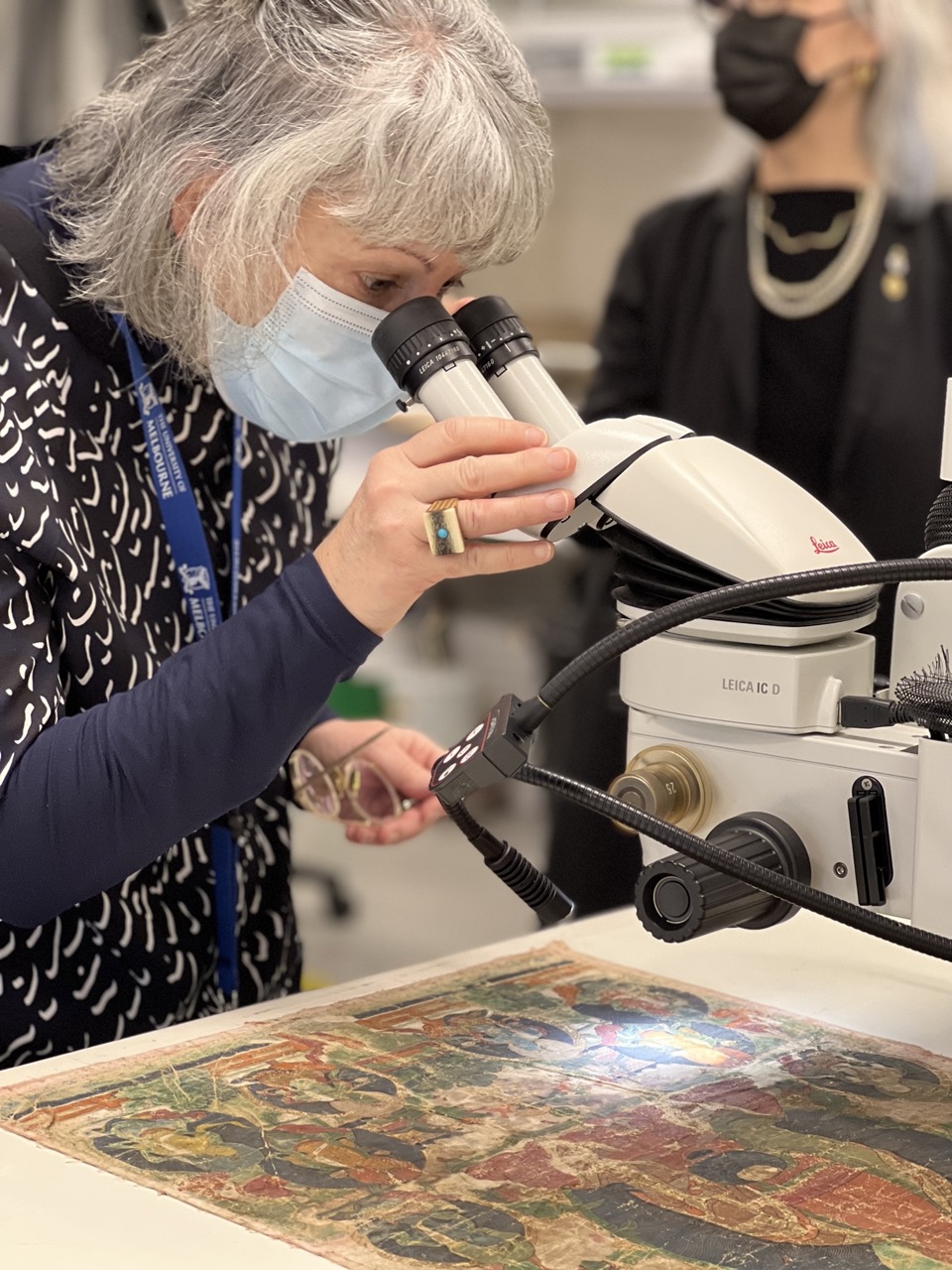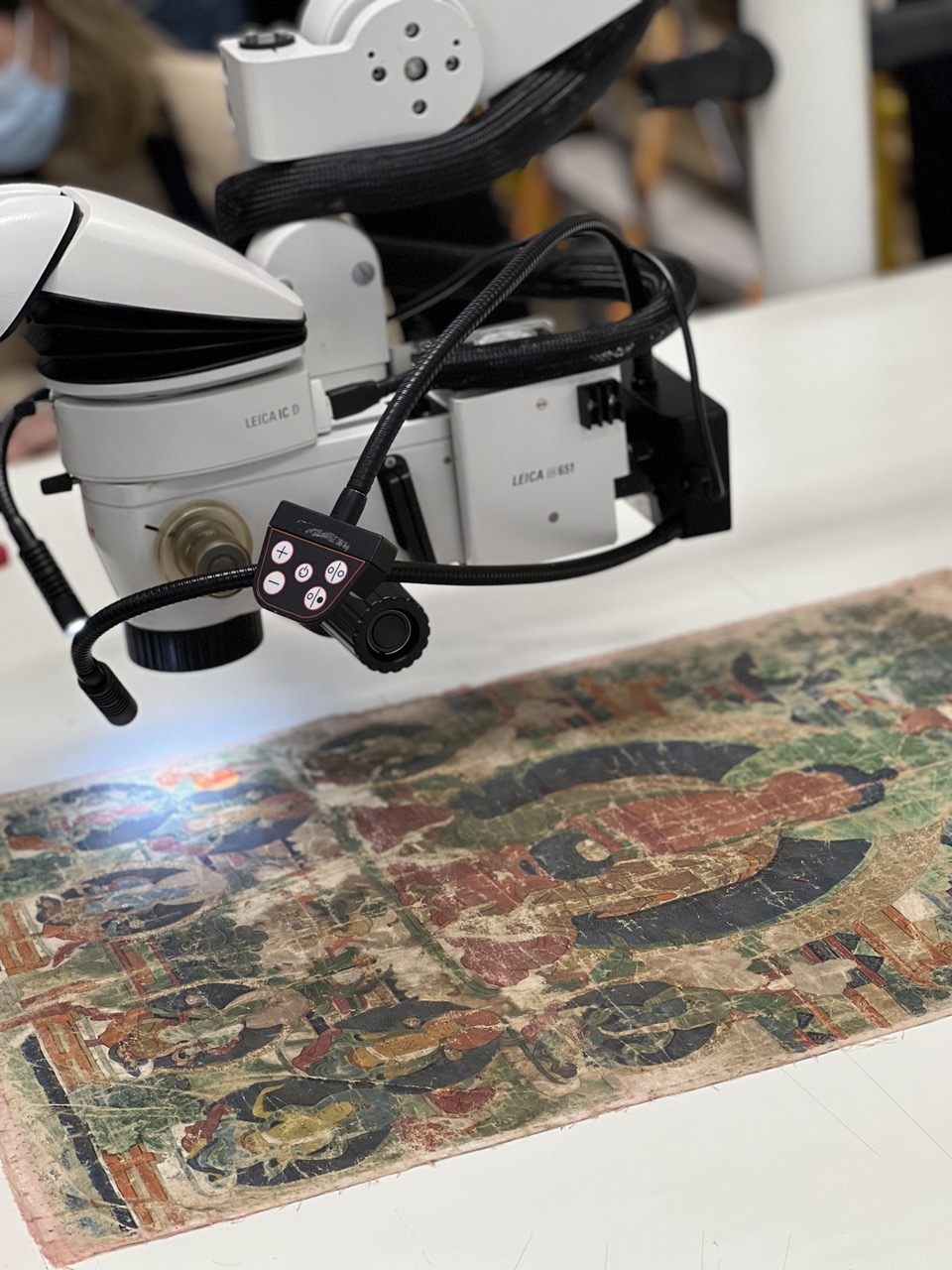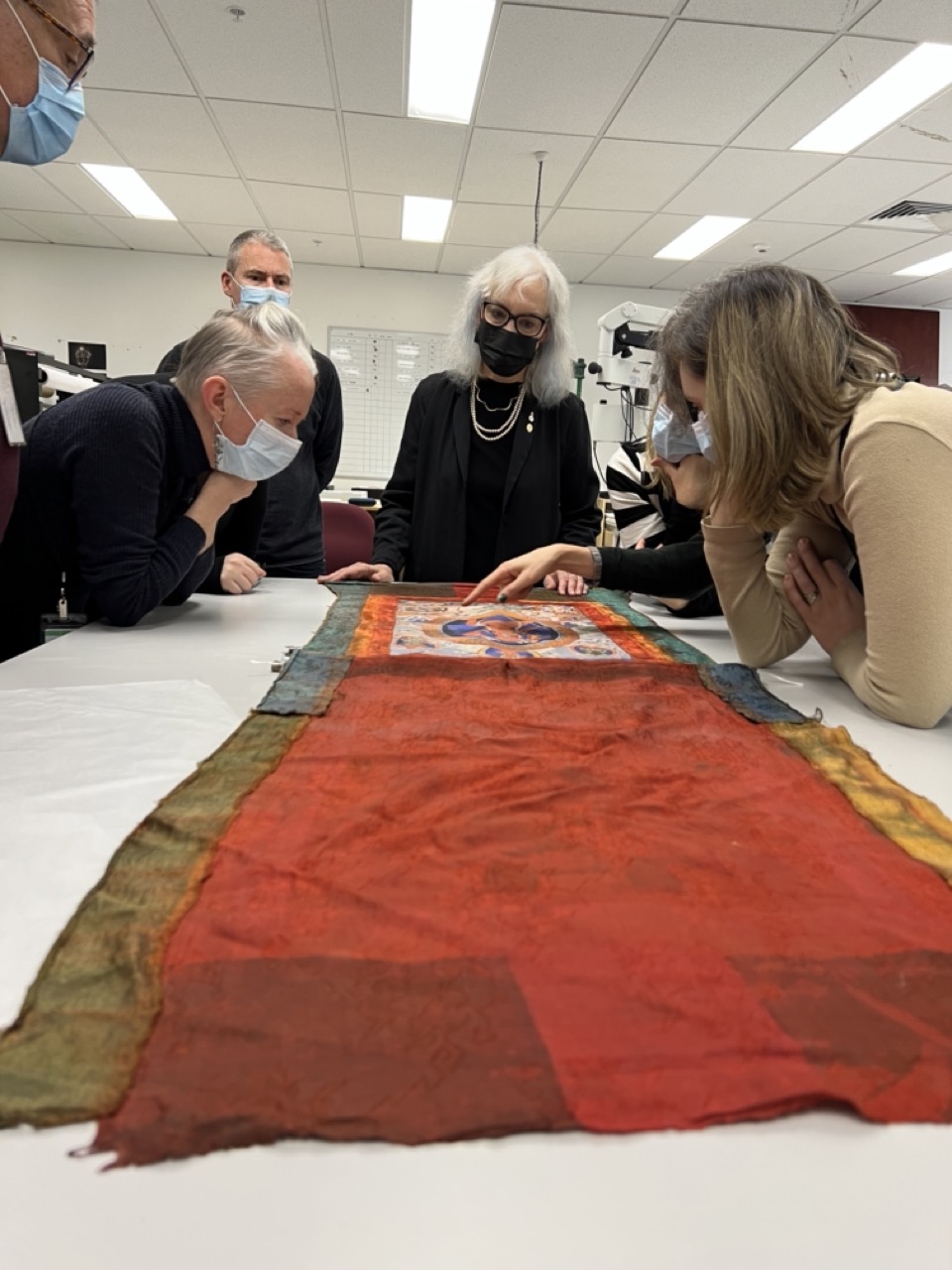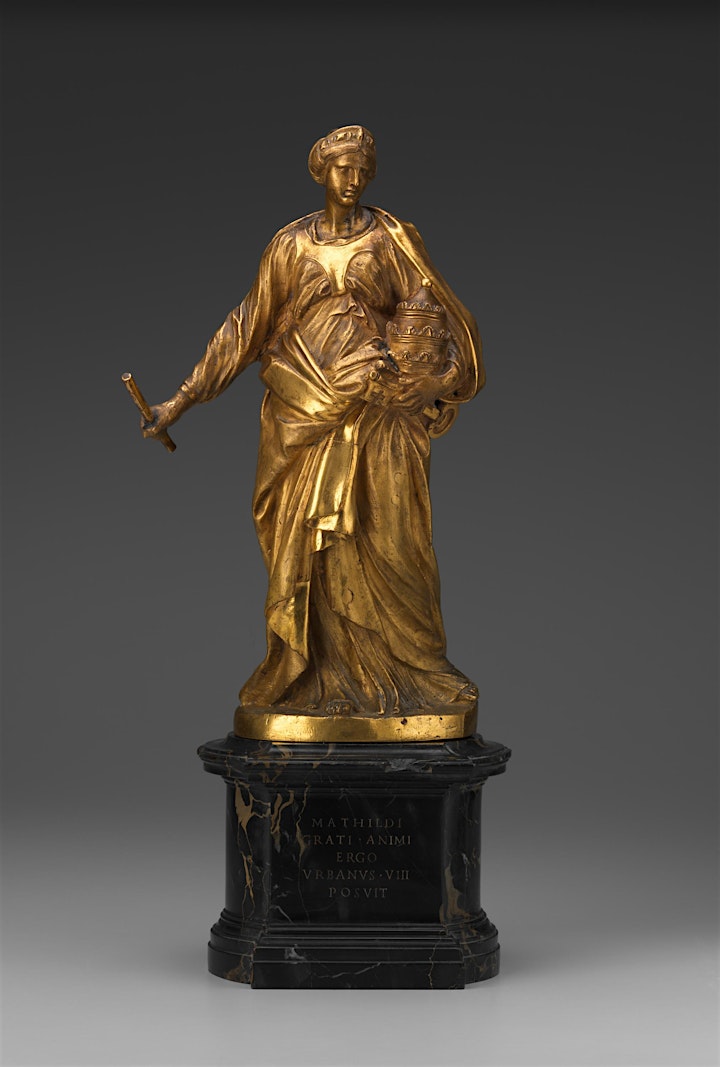Professional Learning
Grimwade Centre for Cultural Materials Conservation is committed to expanding industry skills and experience. Our team provide Professional Learning Experiences for conservators and collection custodians to gain practical experience alongside local and international specialists.

GRIMWADE CONSERVATION EXPERIENCES: conservation professional learning
We provide a range of learning experiences such as Masterclasses, Immersions and Workshops throughout the year delivered by international and local experts.

MASTERCLASS
One day experiences for professional conservators and advanced students. Hosted by international experts.

IMMERSION
Intensive week-long workshops for professional conservators and advanced students. Hosted by local or international experts.

WORKSHOPS
One or half day workshops for collection managers, community custodians and volunteers. Hosted by local conservation experts.
Current opportunities
-
WORKSHOP: Disaster Planning

Our team of professional conservators run half and full-day disaster planning workshops for museums, galleries, archives and keeping places. Workshops can be in onsite or via zoom and are modified to suit your organisations needs.
Contact our team directly to find out more gcs-info@unimelb.edu.au.
Group bookings only
-
WORKSHOP: Basic cleaning and rehousing

Our team of professional conservators run half and full-day demonstration workshops for museums, galleries, archives and keeping places. Workshops are normally onsite in your collection and are modified to suit your organisations needs.
Contact our team directly to find out more gcs-info@unimelb.edu.au.
Group bookings only.
-
WORKSHOP: Collection Care and Object Handling

As conservators, our team are experienced in handling and caring for a wide range of objects and artworks. To induct new staff members or refresh existing teams, our team of professional conservators run half and full-day demonstration workshops for museums, galleries, archives and keeping places. Workshops are normally onsite in your collection and are modified to suit your organisations needs.
Contact our team directly to find out more gcs-info@unimelb.edu.au.
Group bookings only
-
WORKSHOP: Condition Reporting

Documenting and condition reporting objects and artworks can be difficult, but our team of professional conservators have many years of experience assessing a wide variety of objects and artworks and preparing condition reports for touring exhibitions, loans and insurance assessment. To induct new staff members or refresh existing teams, our professional conservators run half day demonstration workshops for museums, galleries, archives and keeping places. Workshops are normally onsite in your collection and are modified to suit your organisations needs.
Contact our team directly to find out more gcs-info@unimelb.edu.au.
Group bookings only
Past
-
MASTERCLASS: Thangkas with Ann Shaftel

International specialist Ann Shaftel led an exclusive Masterclass on the care and conservation of thangkas on 28 July 2022.
Ann Shaftel is a global leader in the field of thangka conservation. She is a renowned teacher of international workshops on the conservation of Buddhist treasures and has shared her knowledge throughout the US, Canada, Europe, Bhutan, Nepal, India and China. She is a Fellow of the International Institute for Conservation and the American Institute for Conservation, and a member of the Canadian Association of Professional Conservators, ICOM and ICOMOS. Since 1970, Ann has worked in the conservation of Buddhist art in monasteries, Dharma centres, museums, universities, and communities. Her work is referenced by international scholars and advised and blessed by Buddhist teachers.








-
IMMERSION: Thangkas with Ann Shaftel

International thangka specialist Ann Shaftel led an exclusive 3 day immersive professional development experience on the care and conservation of thangkas from 1st to 3rd of August 2022.
Over three full days Ann presented lectures and hosted specialist, technical conservation demonstrations where she shared her internationally renown experience and skills with participants.
'...thangkas are complex objects, with intricate iconography and technical construction. Conservators must be fully aware of a thangka's religious and cultural aspects prior to attempting treatment. A combination of media such as textile, painting, wood, and sometimes leather and metal, thangkas require a balanced approach in conservation treatment. The results of inappropriate conservation methods may well prove that the cure is worse than the disease.' Abstract from Conservation treatment of Tibetan Thangkas by Ann Shaftel.

-
MASTERCLASS: Bernini's Bronze

A masterclass about the analysis techniques used by a team of international experts to investigate the bronze sculptures of Gianlorenzo Bernini.
Presented by the Grimwade Centre for Cultural Materials Conservation with the generous support of the University of Melbourne – University of Toronto Joint Research Program.
Program
30 July 2022
11:00am Welcome and Opening Remarks
11.10am The use of X-Ray Fluorescence (XRF) in the study of Cultural Heritage
Aaron Shugar and Branden Rizzuto
Aaron Shugar and Branden Rizzuto give a basic introduction to X-Ray Fluorescence (XRF) and examples of its use in cultural heritage and in an archaeological setting. Issues related to the analysis of metal and calibration, as well as comparable results from other studies will be discussed. While still preliminary, hopeful expectations of the study of Bernini’s Bronzes will be relayed.
Aaron N. Shugar is Andrew W. Mellon Professor of Conservation Science at SUNY Buffalo State and a Professor in the Department of Anthropology at the University of Toronto. His research focuses on the analysis of inorganic archaeological and art materials, historic technologies and the development of analytical instrumentation for use in art and archaeology. He is co-editor of Handheld XRF for Art and Archaeology (Leuven, 2014). For the Bernini Project Aaron is calibrating the XRF instrument and directing the acquisition and analysis of XRF data.
Branden Rizzuto is a PhD candidate in Anthropology at the University of Toronto. His dissertation research focuses on pre-Colombian metallurgy of the Central Andes and the interrelationships between metallurgy, religious practices, and socio-political transformations on the North Coast of Peru during the Middle Horizon Period (ca. 600-1000 CE). A trained archaeometallurgist and analytical chemist, Branden is one of the XRF specialists for the Bernini's Bronzes Project.
12:00pm Technical imaging of bronze sculpture: the use of 3D scanning in the comparison of multiples
Jane Bassett
Jane Bassett discusses the benefits of scanning versus conventional methods of measurement taking, her experience with different scanners as well as challenges presented by current technologies. Special consideration will be paid to 3D scanning in the study of early modern bronzes: i.e. the identification of after-casts, changes in wax inter-models, and as a visual record for further study.
12.45pm Inductively coupled plasma mass spectrometry (ICP-MS) as a compliment to XRF alloy analysis in the Bernini's Bronzes project
David Bougarit, presented by Jane Bassett.
David Bougarit is an Archaeometallurgist who has worked at the Centre de Recherche et de Restauration des Musées de France (C2RMF), Paris, since 1996 where he has been investigating metallic artefacts from almost all historical periods and regions. His primary research interest is the technological approach of copper metallurgy, with a focus on the provenance of copper and fabrication techniques.
1:00pm Exploring the unseen with radiography and endoscopy
Lisa Ellis
Lisa Ellis shares the project’s use of radiography and endoscopy in the investigation of Bernini’s Bronzes. Examples are taken from bronzes studied by the group revealing what radiography can tell us about casting techniques, differing qualities in associated casts and foundry repairs.
1.45pm The investigation of core material: Thin-section petrography, micro-CT scanning, and 3D image analysis
Chandra Reedy via video recording approx. 20-30min
Chandra Reedy's short video tutorial will introduce the project's analysis methods for clay core materials, the refractory material consisting of clay, sand, organic matter, etc., often made with a recipe particular to founders and using locally available components. The function of this material is to fill hollow-cast bronzes to stabilise the figure and to provide a release venue for gases emitted during casting. Some traces of core material are usually left behind and will be collected during examination of the Bernini bronzes. Analysis of this material will be by two methods:
(1) thin-section petrography using transmitted polarised light microscopy to visualise, count, measure, and characterise internal inclusions in the core matrix. The results will help identify geographic point of origin of a cast and will be compared with published clay core analyses of bronzes by other relevant artists.
(2) micro computed tomography (micro-CT) analysis coupled with 3D image analysis will characterise the porosity of solid chunks of material. Since a major function of clay cores are to absorb casting gases and thereby help protect the bronze from casting flaws, understanding porosity characteristics is very important but until very recent advances in micro-CT and 3D image analysis could not be fully studied.
The video will show the basic concepts of thin-section petrography as applied to clay core analysis, the micro-CT methodology employed, and the approach to 3D image analysis.
Chandra Reedy is Professor at the Joseph R. Biden School of Public Policy & Administration and Director of the Center for Historic Architecture and Design at the University of Delaware. She is author of, amongst many other publications, Thin-Section Petrography of Stone and Ceramic Cultural Materials (London, 2008). She has also served as Editor-in-Chief of Studies in Conservation for the past 12 years. For the Bernini Project Chandra will be conducting thin-section petrography, micro-CT scanning, and 3D image analysis of clay core materials.
2.15pm Summary of the technical study of Bernini’s bronzes at the National Gallery of Victoria
Presented by Evonne Levy, Lisa Ellis and Jane Bassett
The Bernini’s Bronzes team will summarise preliminary findings following the examination of the NGV’s Bust of Cardinal Richelieu and the Matilda of Tuscany statuette. We will share our process of discerning the techniques used to cast the bronzes, how we document our observations with iPad Pro images, thoughts about features that may prove to link up with other objects, and especially open questions for the examination of other casts from the same model that we have yet to study.
3pm Panel discussion
Evonne Levy, Lisa Ellis, and Jane Bassett will be joined by world renowned metals conservator Dr Ian MacLeod, Renaissance art historian Prof. Jaynie Anderson (UoM), archaeometallurgist Dr Chris Davey (UoM) and International Art curator at NGV, Laurie Benson to discuss aspects around the materiality and authorship of Bernini’s Bronzes. The session will be moderated by the Grimwade Centre’s Dr Jonathan Kemp.
3.45pm- 5.00pm Reception
Images:
Gianlorenzo Bernini
Countess Matilda of Tuscany (c. 1634)
gilt-bronze
(a-b) 53.7 × 25.4 × 18.2 cm (overall)
National Gallery of Victoria, Melbourne
Felton Bequest, 1970
Photo: National Gallery of Victoria, Melbourne
-
PUBLIC LECTURE: An introduction to the Bernini's Bronzes Project

A technical and art historical investigation of the bronze sculptures of Italian sculptor and architect Gianlorenzo Bernini (1598-1680).
Presented by the Grimwade Centre for Cultural Materials Conservation with the generous support of the University of Melbourne – University of Toronto Joint Research Program.
The Technical Study of Bernini's Bronzes: Art History, Conservation, Material Science
Public lecture presented on 25 July 2022.
Evonne Levy, Lisa Ellis and Jane Bassett
In this introduction to the first international study of ‘Bernini’s Bronzes’, the projects key members, an art historian and two conservators, discuss the genesis of the project, its foundational ideas, and the questions the project will attempt to answer through a combination of art historical and archival research, technical study, material science, and data tools.
Of all the works produced by the Italian sculptor and architect Gianlorenzo Bernini (1598-1680), the bronzes that were cast from his models are undoubtedly the most neglected by art historians. Unsurprisingly, this disinterest extends into the museum and conservation science, with only a handful of technical studies of his bronzes having been undertaken to date. Aside from the challenges of studying monumental works in the Basilica of St. Peter’s, this neglect can be partially attributed to deep-seated modernist myths of the artist-genius and the high value it ascribed to the unique original work of art touched by the hand of the master. The fact that there was always a founder and numerous foundry workers who prepared, cast, and finished the works from start to finish and that the bronze sculptures were often produced in multiples have both proven to be hindrances to the study of ‘Bernini’s Bronzes’. This project valorises both of these aspects of Bernini’s bronze production – the creative labour of the founders and the production of multiples. Through its technical studies the project promises to arrive at a new narrative of the layered authorship of these outstanding works of art.
Evonne Levy is Distinguished Professor of Early Modern Art at the University of Toronto. A specialist in baroque art and architecture and historiography, she is author of Propaganda and the Jesuit Baroque (2005) and Baroque and the Political Language of Formalism (2016). She has published numerous essays on Bernini and co-edited Bernini's Biographies: Critical Essays (Penn State, 2003) and Material Bernini (Routledge, 2014).
Lisa Ellis is Conservator of Sculpture and Decorative Arts at the Art Gallery of Ontario in Toronto and Adjunct Professor in the Department of Art History at the University of Toronto. She was the technical lead for the award-wining exhibition with catalogue, Small Wonders: Gothic Boxwood Miniatures (AGO 2016) a ground-breaking exhibition of more than 60 boxwood miniatures organized in partnership with The Metropolitan Museum of Art and the Rijksmuseum.
Jane Bassett is Head and Conservator of Decorative Arts and Sculpture at the J. Paul Getty Museum. Her major technical studies of early modern bronzes have included co-editing of the conference proceedings, French Bronze Sculpture: Materials and Techniques 16th-18th Century (Archetype 2014) and authorship of The Craftsman Revealed: Adriaen de Vries, Sculptor in Bronze (Getty, 2008). She is a founding member of the CAST:ING project that is establishing norms for the technical study of cast bronze sculpture.
The associated master classes 'Bernini’s Bronze Masterclass' took place at the University of Melbourne 11am- 5pm on Saturday 30 July.
Image:
Gianlorenzo Bernini
Countess Matilda of Tuscany (c. 1634)
gilt-bronze
(a-b) 53.7 × 25.4 × 18.2 cm (overall)
National Gallery of Victoria, Melbourne
Felton Bequest, 1970
Photo: National Gallery of Victoria, Melbourne
Contact us
Have a question about our conservation experiences? Get in touch.
Contact us